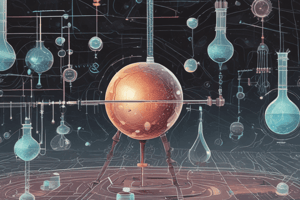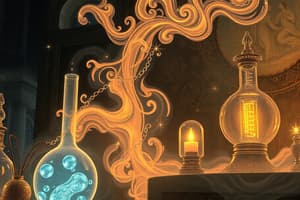Podcast
Questions and Answers
What is the key characteristic of a gas regarding its volume?
What is the key characteristic of a gas regarding its volume?
A gas has no definite volume.
Solid and liquid volumes are greatly affected by pressure.
Solid and liquid volumes are greatly affected by pressure.
False (B)
According to Boyle’s Law, at constant temperature, what happens to the volume of gas when external pressure increases?
According to Boyle’s Law, at constant temperature, what happens to the volume of gas when external pressure increases?
- Volume increases
- Volume decreases (correct)
- Volume becomes zero
- Volume remains constant
At standard temperature and pressure (STP), what is the volume of 1 mol of any gas?
At standard temperature and pressure (STP), what is the volume of 1 mol of any gas?
What does Avogadro's Law state regarding gases?
What does Avogadro's Law state regarding gases?
What is the universal gas constant (R) for the ideal gas law in L·atm/(mol·K)?
What is the universal gas constant (R) for the ideal gas law in L·atm/(mol·K)?
What is the mathematical representation of the Ideal Gas Law?
What is the mathematical representation of the Ideal Gas Law?
What is kinetics?
What is kinetics?
How is the speed of reaction measured?
How is the speed of reaction measured?
What effect does increasing the concentration of reactants have on the reaction rate?
What effect does increasing the concentration of reactants have on the reaction rate?
According to collision theory, particles must collide in order to react.
According to collision theory, particles must collide in order to react.
What happens to the reaction rate if the temperature is increased?
What happens to the reaction rate if the temperature is increased?
What is the general expression for reaction rate?
What is the general expression for reaction rate?
For the general reaction A → B, how is the rate of disappearance of reactant A expressed?
For the general reaction A → B, how is the rate of disappearance of reactant A expressed?
What does a positive sign in the rate expression indicate?
What does a positive sign in the rate expression indicate?
Match the following terms with their definitions:
Match the following terms with their definitions:
What is the role of a catalyst in a chemical reaction?
What is the role of a catalyst in a chemical reaction?
Flashcards are hidden until you start studying
Study Notes
States of Matter
- Gases have indefinite volume, meaning they can change shape to fill their container.
- Solids and Liquids have definite volume and are not affected by pressure changes.
- Gases have no fixed shape, unlike solids and liquids.
- Gases are easily compressed, unlike solids and liquids.
- Gases have low density compared to solids and liquids.
- Gases are miscible with each other in any proportion.
- Gases are composed of particles that have enough energy to overcome intermolecular forces, allowing them to move randomly and independently.
Gas Laws
- Boyle's Law states that at a constant temperature, the volume of a gas is inversely proportional to its pressure, meaning that increasing pressure decreases volume, and vice versa.
- Charles's Law states that at a constant pressure, the volume of a gas is directly proportional to its absolute temperature, meaning that increasing temperature increases volume, and vice versa.
- Avogadro's Law states that at constant temperature and pressure, the volume of a gas is directly proportional to the amount of gas (moles), meaning that increasing the amount of gas increases volume, and vice versa.
Standard Temperature and Pressure (STP)
- STP is defined as 1 atm (760 torr) and 0°C (273.15 K).
- The standard molar volume is the volume of 1 mole of an ideal gas at STP and is 22.4 L.
- The molar volume of a gas is the volume occupied by one mole of gas.
Ideal Gas Law
- The Ideal Gas Law describes the relationship between pressure (P), volume (V), temperature (T), and the amount of gas (n) in moles by the equation PV = nRT.
- R is the ideal gas constant, commonly expressed as 0.0821 L·atm/mol·K.
- The Ideal Gas Law can be used to solve for any of the variables when the other three are known.
Solving Gas Law Problems
- Gas Law problems involve changing conditions, where one or more variables are changed, causing a change in another variable while others remain constant.
- Some problems involve finding an unknown variable, such as pressure, volume, temperature, or amount of gas, when other variables are known.
Reaction Kinetics
- Studies the speed of chemical reactions
- Measured by the change in concentration with time
Factors Affecting Reaction Rates
- Collision Theory: Particles must collide to react
- Concentration: Higher concentration means greater reaction rate, as more particles collide
- Physical State: Reactants in the same physical state or increased surface area, increases reaction rate
- Temperature: Higher temperature means greater reaction rate, as particles have more energy and collide more effectively
- Catalyst: Affects activation energy and rate constant
Rate Expression
- Measures change in concentration of reactants or products over time
- Formula: Rate = [ ] t
- Units: M/s, mol/L.s, Ms-1, mol L-1 s-1
- Time can be in minutes, hours, days or years
- For the reaction A→B, the rate is expressed as:
- Reactant: Rate = - [A]/t
- The negative sign indicates the disappearance of reactant.
- Product: Rate = + [B]/t
- The positive sign indicates the appearance of product.
- Reactant: Rate = - [A]/t
Rate in Terms of Reactant and Product Concentrations
- General form: aA + bB → cC + dD
- Rate = - (1/a) [A]/t = - (1/b) [B]/t = (1/c) [C]/t = (1/d) [D]/t
- Example: 2H2O2 (aq) → 2H2O (l) + O2 (g)
- Rate = - (1/2) [H2O2]/t = (1/2) [H2O]/t = [O2]/t
- Rate of disappearance of [H2O2] is the same as the rate of appearance of [H2O]
- Rate of appearance of [O2] is half the rate of disappearance of [H2O2]
- Rate of appearance of [H2O] is twice the rate of appearance of [O2]
- Rate = - (1/2) [H2O2]/t = (1/2) [H2O]/t = [O2]/t
Rate Expression from Balanced Equation or Vice Versa
- It's possible to write the rate expression from a balanced equation or write a balanced equation from the rate expression.
Studying That Suits You
Use AI to generate personalized quizzes and flashcards to suit your learning preferences.




